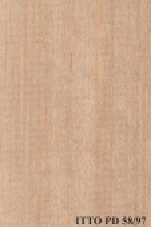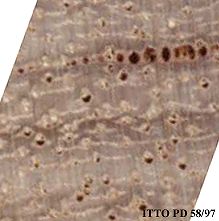
QUARUBA (Vochysia ferruginea)
Trade Name
Quaruba
Scientific Name
Vochysia ferruginea Mart.
Family
VOCHYSIACEAE
Common Names
Itaballi koeleroe (French Guiana); Wossie (French Guiana); Bois cruseau (French Guiana); Achiwa (French Guiana); Chimbulla (Ecuador); Bella maria (Ecuador); Cambara (Bolivia); Gomo (Colombia); Goma amarilla (Peru); Quillo (Peru); Watrakwari (Surinam); Dima vermelha (Brazil); Quaruba branca (Brazil); Malaqueto (Panama); Tecla (Panama); Yemeri Mayo (Panama); Chancho Colorado (Costa Rica); Yemeri (Nicaragua); Orcona (Colombia); Palo Santo (Colombia); Soroga (Colombia); Gamo (Colombia); Laguno (Ecuador); Quillosisa (Peru); Saladillo (Venezuela); Prefontaine Bois (Guyana); Wiswiskwari (Surinam); Wanakwari (Surinam); Tintin; San Juan De Pozo; Red Kwarie; Quaruba (Brazil); Plumero; Palo De Chancho; Moutende (French Guiana); Mayo; Kwari (Surinam); Kouali; Killu Sisa (Peru); Iteballi (Guyana); Grignon Fou (French Guiana); Corosillo; Chimbuya (Ecuador); Cedrorana (Brazil); Cambará (Bolivia); Barbara Chele; Barbachele; Dormilón (Colombia); Goma
Scientific Name Synonyms
Vochya ferruginea (Mart.) Standl.; Cucullaria ferruginea (Mart.) Spreng.
Description Of The Tree
Botanical Description
The trees are reported to reach heights of 25 to 38 m, with trunk diameters ranging from 50 to 70 cm. The boles are straight and cylindrical. It presents small to medium sized buttresses.
Natural Habitat
Vochysia ferruginea is found in well drained soils in the tropical rain forests of Central and South America.
Wood Identification
Anatomic Description Of Wood
Wood diffuse porous. Vessels solitary and in short radial multiples. Tangential diameter of vessel lumina 200 micras or more (large). Vessels per mm2 less than 6 (rare). Simple perforation plates. Vessel-ray pits similar to intervessel pits in size and shape. I Axial parenchyma aliform. Axial parenchyma confluent. 3 to 4 cells per parenchyma strand. 4 to 10 rays per mm (medium). Rays of two distinct sizes. Larger rays more than 4 seriate. Heterogeneous rays and/or multiseriate heterogeneous rays. Occasionally oil and/or mucilage cells associated with the axial and/or ray parenchyma (idioblasts). Body ray Fibers with simple to minutely bordered pits.
-
 Wood Macro Photo Tangential Plane
Wood Macro Photo Tangential Plane
-
 Wood Micro Photo Of Transversal Section
Wood Micro Photo Of Transversal Section
Availability
Cites Status
Unrestricted
General Wood Description
Odor
It has no distinct odor or taste.
Color
The sapwood is pinkish white, the heartwood gradually changes into pink color with darker vascular lines.
COLOR INDEX (1=Black, 7=Light yellow,white)
5
Grain
This timber has usually straight or irregular grain.
Texture
This wood has a somewhat coarse texture.
Luster
The wood exhibits a low to moderate luster.
Natural Durability
The genus Vochysia is reported to be prone to biological attack.
Natural durability index (1= Very high durability, 7=Vey low durability)
6
Resistance To Impregnation
This wood is amenable to preservative treatment.
Wood Physical Properties
Basic Density or Specific Gravity (O.D. weight/vol. green) (g/cm³)
0.47
Air-dry Density (Weight and volume at 12%MC) (g/cm³)
0.51
Drying Defects
Ease of Drying: It is reported to have a moderate rate of drying. Drying Defects: Slight surface checking and warp are reported.
Recommended Dry Kiln Schedule
UK-A; US-T2-D4; JUNAC-A
Wood Chemical Properties
Wood Mechanical Properties
Bending Strength (MOR),12%MC (kgf/cm²)
920
Compression parallel to fiber 12%MC (kgf/cm²)
541
Shear strength radial 12%MC (kgf/cm²)
74
Janka hardness (side) 12%MC (kgf)
256
Janka hardness (end grain) 12%MC (kgf)
440
Workability
Sawing
Wood of this species is easy to cut.
Rotary Veneer Cutting
Some species of Vochysia are interesting for peeling, thermal treatments are recommended.
Sliced Veneer
Some species of Vochysia are interesting for peeling, thermal treatments are recommended.
Blunting Effect
This timber has a slight to moderate blunting effect on the cutting tools.
Planing
It is easy to plane, sometimes woolly surfaces are reported.
Nailing
This species is reported to have a good nailing behavior.
Gluing
Gluing of this species is easy.
Staining
Staining of this wood is easy.
Coatings
It paints and varnishes well.
Polishing
It has a good polishing.
Substitute Species
Cedrela spp.
REFERENCED USES
End Uses Summary
HOUSING GENERAL, beams, joists, boards, flooring, steps, panelling, fittings, FURNITURE AND CABINETS, cabinets, PLYWOOD AND VENEER, PACKING, OTHER AND MUSICAL INSTRUMENTS, handicrafts, moldings
General Housing
- 10 - Silica in Timbers
Beams
- 11 - Prospect: The wood database
Joists
- 12 - Tropical timbers of the world. Part I-Tropical American Species
Boards
- 13 - Dry kiln schedules for commercial woods. Temperate and tropical. Section III. Latin American (Mexico, Central, and South America) Woods–Conventional Temperatures
Flooring
- 14 - Handbook of Hardwoods
Steps
- 17 - Tree Conservation Database
Paneling
- 18 - W3TROPICOS Missouri Botanical Garden
Fittings
- 19 - Silica in Timbers
Furniture Cabinets
- 21 - Tropical timbers of the world. Part III-Southeast Asian and Oceanian Species.
Cabinet
- 24 - Empire Timbers
Panels, Veneers
- 25 - Directory of Timber Trade Malaysia
Packing
- 45 - Recopilación y Análisis de Estudios Tecnológicos de Maderas Peruanas
Handcraft
- 66 - Maderas latinoamericanas. VII. Caracteristicas anatomicas. propiedades fisicomecanicas, de secado, y tratabilidad de la madera juvenil de Cordia alliodora (Ruiz & Pav. Oken.)
Molding
- 79 - Padronização da Nomenclatura Comercial Brasileira das Madeiras Tropicais Amazônicas, Sugestão
Please Provide Information To View Producer Information